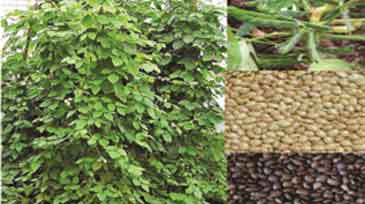India reports slight rise in Covid-19 cases with 3,720 infections
The daily positivity rate presently stands at 2.49 per cent, while the weekly positivity rate is at 3.46 per cent.

Horse-gram
Breaking new ground, a team of scientists at CSK Himachal Pradesh KrishiVishvavidyalaya (HPKV), Palampur in collaboration with Japanese researchers have completed the whole genome sequencing of horse gram, locally known as Kulthi, for the first time.
No genomic information was previously available on horse gram, an indigenous legume of the North-Western Himalayan region having many nutraceutical properties. The scientists have identified 36,000 genes in this crop species, which can be utilised in further breeding programmes.
Advertisement
So far whole genome sequencing of chickpea, pegionpea and partially of wheat, tomato and rice has been done in India.
Advertisement
The draft genome sequence of horse gram was released on Tuesday by Vice Chancellor, HPKV, Ashok Kumar Sarial at Palampur, who told the experts to take this work further through translational research using the information emanating from the study.
“The study will help in improvement and development of horse gram as a commercial crop,” said Rakesh Kumar Chahota, Professor, Department of Agricultural Biotechnology, HPKV. He said the decoding can aid genomics-assisted breeding in this underutilised potential pulse crop and identify key genes responsible for economic traits.
Chahota was a part of the research team with Sachiko Isobe, Head, Laboratory of Plant Genomics, Kazusa DNA Research Institute, Chiba, Japan and TR Sharma, Director, ICAR-Indian Institute of Agricultural Biotechnology, Ranchi. Sharma earlier headed the Department of Agricultural Biotechnology in HPKV.
Sachiko Isobe from Japan gave details on genome sequencing of horse gram. The project was funded by the Department of Science and Technology Government of India and Japan Society for the Promotion of Science, Japan government for two years from 2014-16.
Horse gram (Macrotylomauniflorum) is an important protein supplement of vegetarian diet of large populace of Indian sub-continent.
It is cultivated as a fodder crop in some other semi-arid regions of the world.
In India, horse gram is cultivated over an area of 1.7 mn hectares with an estimated production of 0.58 mntonnes of grain. The grain is used as a human food and also as a concentrated feed for cattle.
It is highly suitable for rainfed and marginal agriculture and thus has a potential to cover the risk of dry land agriculture. Due to its survival capability under drought like conditions, US Science Congress designated this crop as a ‘Crop of Future’.
“Although a crop species of potentially high value, horse gram received little attention of researchers for its genetic improvement because of limited genetic variability and breeding tools. It was immensely important to develop marker resources in this crop species that can be used to assess genetic diversity present in the horse gram germplasm and to develop genetic maps for their use in molecular breeding,” said the research team.
It is for the first time in the history of Palampur varsity that scientists have done whole gene sequencing of any crop plant species.
Advertisement